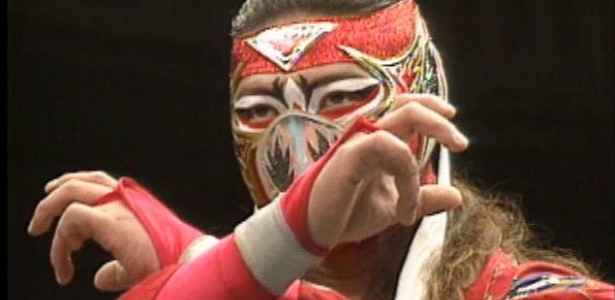
Vice’s Dark Side of The Ring, an often controversial, but fascinating series took a look at Atsushi Onita’s pioneering Frontier Martial Arts Wrestling promotion last week. As infamous as it is legendary, FMW took the wild brawls in Memphis and the barbed wire matches of Puerto Rico, which Onita saw on his travels as a young wrestler for Giant Baba’s All Japan group, and imported those concepts to Japan. Onita spent the formative stages of his career as a light heavyweight wrestler under the All Japan banner until a series of serious knee injuries derailed his career and forced him into retirement. After just a few years on the sidelines, Onita emerged back onto the Japanese scene with the FMW organization, where he could work a ground style that was based on blood, barbed wire, and an over-the-top presentation that thrilled audiences.
The Dark Side of The Ring episode did a fairly accurate summary of the rise and fall of FMW so I thought I’d pen an article about how I discovered the promotion and why it remains my favorite Japanese wrestling organization even today. I’ve watched professional wrestling for as long as I can remember, getting magazines at the grocery story before I was old enough to read just to look at the pictures. I first heard of Frontier Marital Arts Wrestling when I was in elementary school because of it’s association with ECW and references to it in a Pro Wrestling Almanac. At the time, I thought Hayabusa’s costume was awesome and recognized Jinsei Shinzaki as Hakushi. Again, through ECW I knew Masato Tanaka was from FMW and was amazed to see the ridiculous chair shots he took from Mike Awesome. A comical side note, a few years later, I rented a tape (remember video stores?) that was called “Backyard Dogs” since it had pictures from the infamous late-night commercials that advertised VHS backyard footage on the box. I assumed I rented a tape of backyard wrestling matches, which garnered main stream press at the time for untrained grapplers hitting each other with chairs and jumping off of the roof. Instead, “Backyard Dogs” was a movie about backyard wrestling that was more or less the Wrestling Society X version of film. The movie was terrible with goofy sound effects and a story that was so hokey that WCW 2000 angles were entertaining by comparison. The only good thing about this cinematic train wreck was that Hayabusa had a cameo.
I heard about Hayabusa’s injury online, but I had literally just started to get internet access at the time so I didn’t know many details when I was still in middle school. Fast forward a few years and when I was in high school, I randomly saw a kid in another grade wearing an original ECW Fully Bloodied Italians t-shirt. He was somewhat of an odd bird, but harmless and he meant well. When he would stop random people in the hallway and tell them he hoped they had a nice day, he actually meant it. Since the fellow was genuinely wishing people well, I made sure to say hello to him when I could since it’s not that difficult to be kind to other people. One day, I asked him where he got the original ECW t-shirt, and he explained that he bought it from George Mayfield, who sold many compilation tapes at independent shows and conventions for years before the internet made such footage much more accessible.
He made a point to tell me about a lot of obscure Japanese wrestling references nearly every time I saw him and mentioned that I should watch some of these shows. Ironically, this dude had HUNDREDS of VHS tapes from Highspots when the online store sold footage from Samurai TV, but didn’t have some of the rather easily found WWF pay-per-views from the previous decade. We started trading tapes, as he would bring a bag of those random VHS tapes to school and let me make copies over the weekend, and would include a series of blank tapes so I could make copies of those WWF PPVs for him. He didn’t have two VCRs to dub tapes, but I didn’t mind the extra copying process since he was nice enough to allow me to make copies of shows I hadn’t seen before.
Eventually, he sold his entire wrestling tape collection the following year and became a hardcore political viewer so I’m not sure what he’s up since 2006, but wherever he is, I hope he’s doing well. When he was in the process of selling his collection, he sent me an AIM message and told me that he had a bag of VHS for $20 so I agreed to the purchase. When I got them, there were dozens of Japanese, ECW, and indy shows suffered into a garbage bag.
However, I must go back to the initial tape swap when he gave me a bag of VHS to copy, and one of them was the FMW Kawasaki Stadium 1996 event. Despite being taking place almost a decade earlier, the event was my full-fledged introduction to Frontier Martial Arts Wrestling. As mentioned, I was familiar with FMW, but was memorized by the violence spectacle on screen. There were some fun brawls on the show, including Cactus Jack vs. Wing Kanemura, who I saw previously in ECW, but the two featured matches are what made me track down as much FMW content as possible soon after that. Combat Toyodo vs. Megumi Kudo in an exploding barbed wire match was absolutely insane. It was violence with a level of psychology and storytelling that usually isn’t seen within the genre. The main event was Hayabusa and Masato Tanaka vs. Terry Funk and Mr. Pogo in an exploding ring match. Again, the spectacle was insane, but was a compelling showcase of death match wrestling.
I watched and dubbed as much FMW as I could find in the few years after that, garnering a decent collection of footage from throughout the company’s history. Thankfully, most of the main footage is on Youtube in some form now, but before that, even when VHS was a fading form of media, I dubbed dozens of FMW tapes just to be able to watch more of the promotion. Also since that time, I found some original FMW programs online that are some of my favorite items in my extensive wrestling collection. Ironically, one of those programs was given to me as a Christmas gift just a few years ago. Within my adventures as a commentator on the local Pittsburgh scene, I’ve been very thankful to be able to work with and call matches for some very talented wrestlers. Shirley Doe, who actually designed some of Mick Foley’s famous airbrushed t-shirts in ECW, is one of the people I respect the most in the wrestling business. He’s one of the genuinely good people in life and his vast knowledge of the sport is an asset to any organization. Doe, who has competed for 26 years, actually worked a few tours of Japan, appearing on the previously mentioned Samurai TV. As mentioned, he gave me a Christmas gift a few years ago, it was an original FMW program from 2000 and it’s one of the nicest gifts I’ve ever received. I gave him an Akira Maeda figure that year to go along with a Riki Choshu figure I gave him as a birthday gift previously. The diehard wrestling fans will get the reference.
As we saw last week on Vice TV, nearly 20 years after FMW closed its doors, the company has an enduring legacy. If I had to guess I’d say that the influential style and some of the infamous antics are what kept the organization in the conversation for the past two decades. There were so many compelling characters and wild matches that FMW was undoubtedly a fun viewing experience. Hayabusa was a death match wrestler, but his aerial moves had such grace as he soared with a variety of dives outside of the ring. Mr. Pogo carved his opponents up with a sickle and looked like a maniac. Onita, as shady as he might’ve been as a business man, was one of the most charismatic performers of his generation. It speaks volumes to the accomplishments of the company and its performers that it’s still a topic of conversation within the industry.
What do you think? Comment below with your thoughts, opinions, feedback and anything else that was raised.
Until next week
-Jim LaMotta
E mail [email protected] | You can follow me on Twitter @jimlamotta







